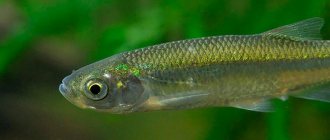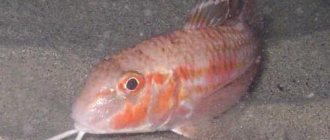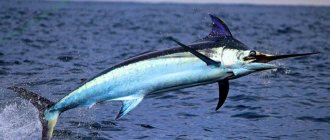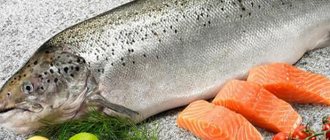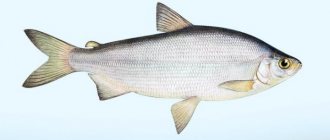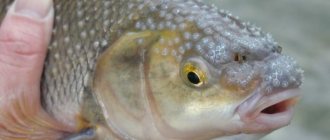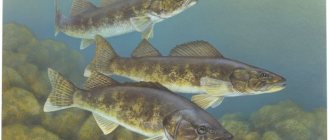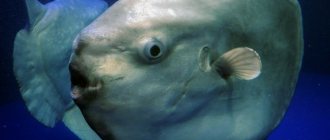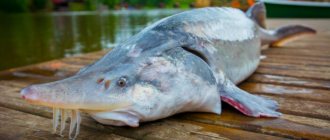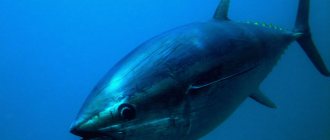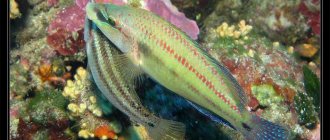Description
The length of this representative rarely exceeds 11 cm. The spined loach is easily distinguished from other fish by its elongated, laterally compressed body. Compared to the body, the head is very small. The caudal fin has a rounded shape.
The mouth of the spined fish is directed downwards, which indicates the bottom feeding nature of this fish. There are small antennae in the corners of the mouth and on the lower lip, which have good sensory properties and help in searching for food. The scales are very small and at first glance it may seem that they are not there at all.
Interesting! There is a small spike under the eye of the fish, which extends if the spined fish senses danger. If handled carelessly, a fisherman or aquarist can receive a rather painful injection, the wound from which does not heal for a long time.
The spined loach has excellent mimicry abilities. Its variegated color makes the fish completely invisible among the sand and stones. If necessary, she can quickly change from a light palette to a dark one.
Before spawning, the color scheme of the scales becomes brighter and more expressive. Females differ significantly from males in several ways:
Eel fish: description and photo
- larger sizes;
- shorter pectoral and ventral fins;
- the absence of the Canestrini organ, which is a bony plate on the pectoral fin.
Good mimicry abilities allow the spined loach to remain unnoticed by predators and fish-eating birds.
Depending on the species, the Canestrini organ in male spined loaches can have a different shape.
Economic importance
In addition to the fact that this fish is quite small, it is not so easy to catch, because it spends a significant part of its life at the bottom of the reservoir, buried in the sand. Therefore, it is not eaten, but it has a lot of positive qualities, which is why it has gained enormous recognition. Eg:
- Many fishermen use it as live bait.
- The spined loach feels great in artificially created conditions.
- By pinching it is possible to determine atmospheric pressure. If the pressure drops, it floats to the surface and begins to behave not quite adequately.
Knowing this, many fishermen take it with them in containers when fishing. In most cases, at low pressure the fish do not bite well, or do not bite at all.
If you keep the spined loach in an aquarium, be sure to remember that it does not tolerate sunlight. In such conditions, it burrows into the ground and leaves its shelter only in the evening.
Habitats
The spined loach feels quite comfortable in various types of reservoirs. It can live both in stagnant lakes with a muddy bottom and in fast rivers with sandy or rocky substrate. This fish leads a bottom lifestyle and burrows into the ground at the slightest danger.
Reference! In shallow rivers, this representative of the ichthyofauna likes to stand in areas overgrown with filamentous algae. The basis of its diet consists of small insect larvae. Fish exhibit increased feeding activity in the pre-sunset hours.
Lifestyle: diet
Because the fish does not differ in significant size, but on the contrary, its diet consists of small invertebrates and the larvae of various insects that live at the bottom of the reservoir. The spined lance prefers to live in clean water; it does not like rapid currents, nor does it like stagnant areas. Despite this, the oxygen content in water, or rather its percentage, does not really puzzle the spined loach, since it is capable of breathing atmospheric air.
Inhabits rivers and lakes. Leads a bottom-dwelling lifestyle and buries itself in the sand when there is any danger. It can also hide among algae, hanging on stems or pages. Therefore, the spined lizard has another name - water lizard. Prefers to lead a solitary lifestyle. It begins to show its activity at dusk.
In her intestines there are quite a lot of blood vessels, which extract oxygen from the air. In order to breathe, the spined loach sticks its mouth out of the water. For a long period, the spined loach is able to eat nothing if there is no suitable food for it. Such factors make it possible to breed this interesting fish in an aquarium.
Spawning
In the spring, the spined loach comes to shallow, grassy areas with a depth of no more than 30 cm and begins to spawn. In the southern regions, spawning time occurs in May. In the middle zone - for June. Despite its modest size, the fish's caviar is quite large (about 2 mm). There is an air bubble between the embryo and the shell, which allows the egg to constantly remain in the water column.
About a month after hatching, the fry begin to develop external gills. Adults can breathe using their intestines, which allows them to survive in the most unfavorable conditions.
Throughout the warm season, plucking is carried out in areas with a depth of 20 to 70 cm. With the arrival of autumn and cooling of the water, the fish move to pits, where they remain until spring.
Appearance and description
The spined loach is an unpretentious small fish that lives among aquatic vegetation. There are several subspecies that are very similar to each other, which can only be distinguished by an ichthyologist. The maximum size of the fish is 13 cm. The body is serpentine-shaped, flattened from the sides. The scales are small, almost indistinguishable.
The feeding habits of the fish are reflected in the structure of its head and mouth: the mouthparts are designed to obtain food from the bottom and directly from the soil, and there are near the mouth , making it easier to find food in the soil . The mouth is able to move downwards. Another characteristic feature of the fish is that it has a spike under the eye.
The color of the fish is yellowish-gray, highly dependent on the habitat, and can be lighter, even silvery. Dark spots are scattered along the lateral line, forming a continuous chain.
Shchipovka
Diet of the common spined loach
The spiny lobster feeds on small invertebrates or larvae. Does not eat plants or algae. If there is no suitable food nearby, the spiny can withstand quite long periods of hunger. The young of the spiny fish feed on ciliates and rotifers, and only after a few months (approximately mid-autumn) do they switch to the adult menu.
Mating season
As soon as the water warms up to 16 degrees in the spring, spawning begins in the spiny fish. The fish are sedentary by nature and are not subject to migration, but during the spawning period they still gather in small schools and go to the nearest shallow water. The mating process is quite interesting and exciting. The male first catches up with the female for several hours and tries to seduce her. Like a true lady, the fish “breaks” and resists, and, in the end, gives in to the advances of the persistent groom. The process of intercourse itself lasts up to six hours and consists of rapid circling with the laying of eggs on moss bushes or filament. After a certain break, the studs can continue to spawn, and this can continue for up to 2 months. During the season, the female is able to lay up to 3000 eggs.
Neither cooks nor fishermen
For fishermen , the spined loach is of little interest. Due to its small size, the spiny fish is not a trophy fish, so it itself is sometimes used as bait for catching larger fish - pike perch, perch, pike, burbot. The spined loach bites on bloodworms, caddis flies, and earthworms. In addition to using a fishing rod, you can catch fish directly with your hands or with nets between stones. For the same reasons, pickled fish are not of interest to culinary specialists - they are small, bony and not particularly tasty, so the fish is not eaten.
Behavior and habitat
Most often, ordinary podust is found in the European part of Russia. Its usual habitat also includes the basins of the Caspian, Black, Azov and Baltic seas. This species feels most comfortable in large rivers with medium and fast currents, and tries to avoid places with standing water.
In reservoirs it prefers to be located in areas with a clay or rocky bottom, as well as near snags. Podust is a typical peaceful fish that feeds on organic remains that have settled to the bottom, microscopic algae growing on stones and snags, as well as larvae, insects and bottom invertebrates.
This species prefers to stay in flocks, moving around the reservoir in search of food. The fish reaches sexual maturity at the age of about 3 years. At this point, its length is about 20 centimeters, and its weight reaches 200 grams. After reaching this stage of development, the pods go up the river to spawn. This usually happens in the second half of spring (April or May).
This is interesting! During the spawning period, the fins of this fish acquire a brighter color, yellowish-orange spots appear on the gill covers and the edges of the mouth, and the scales of some individuals become covered with black dots.
Schools of podust look for areas of reservoirs with a pebble bottom and a fairly strong current as spawning grounds, where females lay from 15 to 110 thousand eggs, which stick to the stones. The development of eggs takes about a week, and during this time an impressive part of it is eaten by fish, including the podust itself. It is included in his main diet, but he cannot be called a big gourmet. He doesn’t care whether he eats frog caviar or his own.
Description of the fish
There are several subspecies of roach:
- common, living almost everywhere in fresh water bodies of temperate climates;
- Siberian (aka chebak) - its range covers the Urals, Siberia and the Far East;
- Aral - living in the remnants of the Aral Sea and the rivers of its basin;
- Caspian vobla (found in the lower reaches of the Volga and the Caspian Sea);
- Azov-Black Sea ram, living in the corresponding reservoirs.
The last two listed species are of commercial importance, and in fact, when talking about ram fish, these are the species that are meant.
Vobla is endemic to the Caspian Sea. There are three groups of separate flocks:
- North Caspian;
- Azerbaijani;
- Turkmen
This fish spends most of its life in the sea, only rising into large rivers (primarily the Volga) during spawning. Its main difference from ordinary roach is its large size. Possessing an excellent food supply, the roach can reach a length of up to 30 cm or more. The mass of most specimens is about 300-500 g, but individuals weighing more than 1 kg are often found.
The fish also differ in appearance: unlike the roach, which has orange eyes, the roach has silver eyes. There are black spots above the pupils.
The fins of the roach are dark red in color with a characteristic black border along the edges.
The habitat of the ram is the Black and Azov Seas. This fish enters large rivers belonging to their basin:
- Dnieper;
- Don;
- Kuban;
- Danube;
- Mius, etc.
Externally, the ram resembles a roach, but has a slightly larger body height. The size of adult individuals ranges from 15 to 20 cm and weighs 400-500 g. Large specimens are occasionally found, reaching 35 cm in length and weighing up to 1.8 kg.
The body of the ram is elongated, pressed laterally and relatively high (up to 12 cm). The color of the fish is characteristic of most cyprinids: silvery scales, brown upper back and head, white or yellowish belly. The lateral line is almost invisible. Externally, males and females look almost identical.
The head of the fish is small, occupying no more than 1/6 of the body length. It has a triangular shape. The ram's mouth is small, located at the bottom of the head. The fish's eyes are large and have a golden hue.
The coloring of the ram's fins is characteristic: they are greenish-orange with a black edging around the perimeter.
To summarize, we can say that the differences between a roach and a ram are as follows:
- Different habitats, populations in principle do not intersect.
- The ram has smaller scales.
- The fins of the roach are dark red, while those of the ram are greenish-orange.
- The ram has a semi-lower mouth, while the roach has a straight mouth.
- The eyes of the roach are silvery, the rams are golden.
Lifestyle
Young spined loach species are active during the daytime; older individuals begin to show their activity in the late afternoon. Reproduction begins when the water temperature becomes at least 16°C, mainly at the end of April and May; in Russia, in areas closer to the central European part, spawning takes place in June-July. Spawning takes place off the coast, in shallow water. The duration of batch spawning is 1-2 months, the female throws out eggs with a diameter of 1.9 mm, which swell to 3.0 mm. Fertility is low - from 150 to 2660 thousand eggs, in warmer regions it increases to 460-5070 thousand. The eggs mature in a suspended state, since they have a very small specific gravity; the female throws them between long algae.
The larvae begin to bite on days 4-6, depending on the water temperature, and their length reaches 4 mm, after which they continue to live in the algal shelter until the larvae grow spines and develop external gills. During the growth period, the larvae feed on small mollusks, ciliates, and plankton. Adults feed on crustaceans (cyclops, daphnia), insect larvae and chironomids that live in algae threads and eat plant seeds. Having reached a length of 18-20 mm and a weight of 0.05-0.15 g, the fry switch to a bottom habitat.
The habitat can be reservoirs with running and standing water, shallow estuaries, spring and dug ponds, ditches; channels with a slow flow, sandy-muddy or rocky bottom with shallow water are most suitable for it. In sandy soil it burrows completely and even makes passages for itself, hides between stones in reservoirs with a rocky bottom, can take on a curved shape and be suspended. Leads a secretive solitary lifestyle, can be found in a group of several individuals, a sedentary species that does not make any movements. In summer, the spined loach often hides in filamentous algae or mud, where it finds a large amount of food consisting of small organisms.
Reproduction
The spined loach spawns in the spring, like many other fish species, going to small rivers where females lay eggs in shallow water. After about 5 days, spined lance fry appear and hide in the algae. The fry develop external gills, which is due to the low oxygen content in the water. As they grow older, the gills disappear. At the end of summer, spined lance fry leave shallow waters and move to huge rivers, where they spend the winter.
